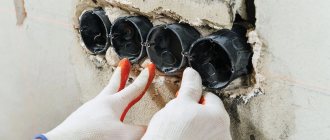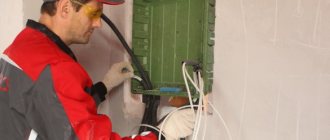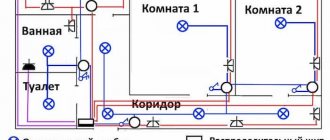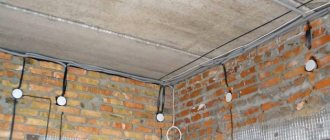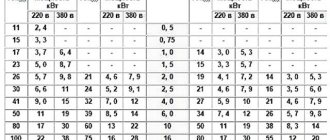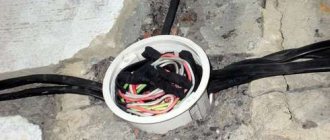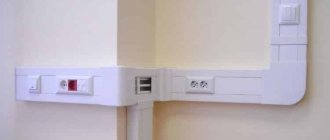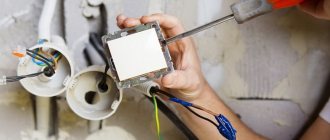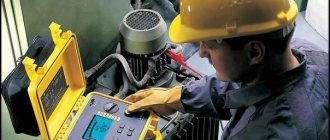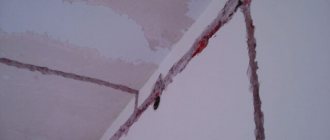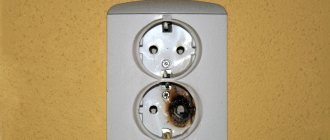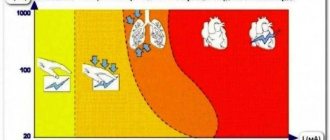Ensuring the fire safety of an apartment or any other object is achieved through preventive actions on the part of both the Ministry of Emergency Situations and the owners themselves. In this case, we will consider a residential apartment, although fire safety rules and requirements for electrical wiring are also relevant for other premises (office, enterprise, etc.) In the publication about a fire in an apartment, the cause is often faulty electrical appliances or electrical wiring. Both reasons are often caused by the desire to save money, that the stingy pays twice and it is often better to overpay and buy high-quality wiring, so as to be sure of safe operation. This principle should be followed when designing and installing electrical wiring in an apartment or house.
Electrical wiring is a set of wires and cables with associated fastening elements, supporting and protective structures and parts regulated by standards.
Rules
Ensuring fire safety is generally accepted and recommended by everyone in the use of copper cables for electrical wiring. This is the case when you need to spend money, but at the end you get a higher quality “product” than if you use an aluminum cable. The use of aluminum wiring is permissible according to the PUE, but with certain conditions, read about this in the PUE.
In short, the negative factors when using aluminum wiring can be listed as follows:
- a large cable cross-section of at least 16 mm2 is required;
- greater specific electrical cross section compared to copper, the difference is almost two times. Thus, at the same voltage, the aluminum conductor should be twice as thick as the copper conductor;
- Compared to aluminum, copper is much more elastic.
I hope you have decided on the wiring - it’s up to you to decide which one you will take, copper wiring or aluminum. It remains to choose a cross-section for an ordinary residential apartment? This is where you can approach it differentially and save a little.
On this topic ▼
Fire safety in the workplace
Types of briefings and basic rules of industrial safety
There are two types (sources) of electricity consumption in the apartment, which goes to:
- Room lighting.
- Ensuring the operation of electrical appliances.
Since the current consumed for lighting the room is not very large, you can get by with a cable of a small cross-section, for example 1.5 mm2, but connect a cable with a large cross-section to the main source of energy consumption, here you need to look at how many and what kind of devices will be installed indoors.
If you take an average apartment with a standard set of equipment (TV, computer, electric kettle, microwave oven, etc.), you need to take a cross-section of at least 2.5 mm2 to ensure the fire safety of the apartment.
It should also be noted that when choosing electrical wiring, and especially when purchasing it in a store, you need to look at compliance with the safety requirements for this product.
Fire safety of electrical wiring is ensured by compliance with the basic requirements:
- correct choice of the type of electrical wiring and method of its installation;
- compliance of the type of electrical wiring and the characteristics of the wires, cables and pipes used with the acceptable methods of laying on supporting foundations and structures;
- correct choice of electrical protection.
- Electrical wiring must meet all environmental requirements (for example, hot and dusty rooms).
- convenient cable routing, which facilitates quick localization of the fire source.
- Installation of electrical wiring must be carried out by specialists.
Selection of cable cross-section depending on the load current
Personnel access groups
Fire safety at the enterprise: documents
In accordance with regulations, there are 5 main groups of personnel:
- Group 1 practically does not interact with devices and does not require special knowledge;
- Group 2 carries out periodic interaction with installations; obtaining it requires completing an initial training course;
- Group 3 requires special knowledge and a training course of at least 108 hours. Such employees are allowed to work with installations with voltages over 1000V
- Group 4 can be assigned to responsible occupational safety specialists and heads of staff departments;
- Group 5 requires, in addition to special skills and knowledge, also relevant engineering education in the electrical field.
Requirements
According to information from the magazine “CABLE-news”
The risk of fire in/from electrical wiring must be minimized by selecting the appropriate type of electrical wiring, fire hazard class of cable products, base material for its installation and performing electrical installation work in accordance with the requirements of GOST R 50571.5.52-2011.
The manufacturer of cable products must develop technical documentation (passport) containing information about the fire safety of specific brands of cable products. The fire hazard class of cable products must be determined in accordance with the requirements of GOST 31565-2012.
The choice of the type of electrical wiring and methods of its installation is carried out in accordance with GOST R 50571.1-2009; GOST R 50571.5.52-2011.
Electrical wiring laid openly must be flame retardant.
Non-propagation of fire is ensured by:
- the use of flame retardant cables in accordance with GOST 31565-2012;
- laying cables, including “without designation” versions, in steel pipes or by embedding them in non-combustible building structures;
- laying cables in steel boxes with lockable lids, while the volume occupied by cable products must be at least 30% of the volume of the box. Fire-resistant, non-combustible seals must be made inside the boxes along the length of the line, taking into account the boundaries of the fire compartment, as well as at the points of entry and exit of wires and cables. The same seals for long compartments are performed every 30 m on horizontal sections and every 20 m on vertical sections of the line.
When the total volume of flammable mass of cable products in the electrical wiring reaches above the permissible value for the given category of cable fire retardation indicated on it in the marking (AF/R, A, B, C, D), the cable thread must be marked with a material that is permissible for use. The outer sheaths of the cables are covered with a fire-resistant cable coating (FCC) along its entire length.
On this topic ▼
Fire safety during construction
Buildings, private houses or baths
Also, OKP must be applied to prevent the spread of fire to cable products in the “without marking” design when they are laid in groups in production areas where only periodic presence of maintenance personnel is possible.
The fire-retardant effectiveness of the OKP must be determined according to GOST R 53311-2009, taking into account the materials of the sheaths or external protective covers of the cables, in accordance with the scope of application of the specific OKP.
In case of hidden, embedded electrical wiring in building structures made of non-combustible materials, it is allowed to use cable products with the type of execution “without designation” in accordance with GOST 31565-2012.
In the case of laying such cables in channels of non-combustible building structures, the inlet and outlet openings of the channel must be sealed with non-flammable fire-resistant sealing materials.
The electrical wiring of the fire safety system of the facility must remain operational in fire conditions for the time necessary to perform their functions and evacuate people to a safe area (Article 5 and Article 82 No. 123-FZ).
The actual operating time of electrical wiring under conditions of exposure to standard fire temperature conditions is determined according to GOST R 53316-2009.
Achieving the required operating time of electrical wiring under fire conditions must be ensured by using:
- fire-resistant cables in accordance with GOST 31565-2012;
- fire-resistant cables with mineral insulation (KMZH, KMI);
- fire-resistant cable ducts;
- a method for laying cables inside fire-resistant building structures with the implementation, if necessary, of compensation measures to ensure the functioning (operability) of cable products for a given time.
When electrical wiring crosses a building structure with a regulated fire resistance limit, a cable penetration with a fire resistance limit not lower than the fire resistance limit of the structure being crossed must be installed at the intersection, in accordance with the requirements of GOST R 53310-2009.
If there are cable boxes in the penetration, they are sealed both inside the box and outside.
For building structures whose fire resistance limit is not standardized, the passage must be sealed with non-flammable, crack-resistant material to the entire depth of the penetration.
Electrical wiring behind impenetrable suspended ceilings is carried out in the following way:
behind suspended ceilings made of flammable materials - in metal pipes with localization ability and in closed boxes;
behind ceilings made of non-combustible materials and combustible materials of group G1 - in pipes and ducts made of non-combustible materials, as well as flame retardant cables (ng-LS, ng-HF, ng-FR).
In the latter case, during design, the volume of flammable mass of cables contained in a meter section of cable flow is calculated. Based on the calculation results in accordance with SP 5.13130.2009, a fire protection system for the above-ceiling space is selected: AUPT - automatic fire extinguishing installations or AUPS - automatic fire alarm installations.
In wooden residential buildings with a height of no more than two floors, electrical wiring is allowed inside the enclosing wooden structures (walls, partitions) of residential premises.
Electrical wiring must be done in one of the following ways:
a) laying cables with copper conductors according to ng(A)-LS GOST 31565-2012 in metal hoses with a diameter of 16-20 mm;
b) pipeless laying of cables with mineral insulation (KMZh type);
c) laying cables with copper conductors in the ng(A)-LS version in accordance with GOST 31565-2012 in flame retardant molded electrical installation products that meet the requirements of GOST R 53313-2009.
In attics, garages, boiler rooms and other technical rooms of these houses, electrical wiring must be carried out in accordance with GOST R 50571.5.52-2011, the requirements of Section 4 of this Code and rules SP 31-110-2003.
Mounting (junction) boxes installed on/in wooden structures and intended for mounting electrical installation products and connecting wires in them must meet the requirements of SP 31-110-2003, clause 14.20 and should not serve as a source of ignition for these structures if a short occurs in the cables short circuit, overload or unacceptable heating in contact connections.
The connection of wires inside the box must be made using screw or screwless contact clamps that meet fire safety requirements in accordance with GOST R 50043.2-92, GOST R 50043.3-2000 and GOST R 51686.1-2000.
Inside wooden residential buildings (clause 4.12), it is allowed to use open laying of single cables in the ng-LS version on a wooden base, both directly and outside of flame-spreading molded electrical installation products in accordance with GOST R 53313-2009, while the cross-section of the current-carrying conductors should not exceed 6 mm2.
Cable and wire lines must be protected from short circuit currents and overloads.
To protect against fire, residual current residual current circuit breakers (RCDs) must be installed, and the protective conductor must not pass through the window of the device’s magnetic circuit.
An RCD-D with a response current of up to 300 mA to protect electrical wiring from fire from leakage currents, as well as in case of short circuits to grounded parts of electrical installations, is installed in electrical networks and in cases where the magnitude of the emergency overcurrent is not sufficient to trigger the maximum current protection.
Rules for safe operation
During the operation of electrical equipment, various emergency situations may arise, for example:
- Instruments and devices suddenly begin to spark;
- Employees working on the equipment report elevated temperatures. Symptoms of a malfunction and short circuit are also overheating of the wires, which occurs due to excessive load in the network or improper connection of devices;
- Weak contact at the point where the device is connected to the electrical circuit (for example, a loose socket or broken plug), which also leads to overheating of the wires and subsequent fire;
- When the device is disconnected from the network, an arc occurs, which indicates a malfunction of either the equipment or wiring. In addition, the electric arc itself can lead to injury, since it has a fairly high voltage level;
- If there is a transformer in the device, the temperature of its winding should be monitored, since its sharp increase indicates the presence of overload and operational problems.
Conditions for safe operation of electrical installations
If such a situation arises, it is necessary to act in accordance with the fire safety instructions approved by the enterprise. At home, it is recommended to follow basic fire safety rules: do not plug in a faulty device and contact a specialist for repairs.
Important! The most important fire safety rule when operating electrical installations is the requirement to disconnect them from the network after use. It is not allowed to operate electrical equipment in the absence of a person, as this may lead to a fire. Only those devices that are necessary to maintain life can be permanently connected to the network.
Fire safety rules (FPR), both at the household level and at the enterprise, prohibit the following actions:
- Operation of faulty electrical equipment;
- Violation of the requirements of the manufacturer of electrical devices regarding the organization of safe work on them and maintenance rules;
- Cover lamps and lamps with any material, especially flammable (paper, fabric, etc.), since light sources also emit heat during operation, and an increase in the temperature of paper or fabric can lead to their fire. In addition, it is not recommended to use lamps without a diffuser in everyday life or in production;
- Operate the equipment without special stands made of fireproof material;
- Use home-made devices for work that have not passed the appropriate certification;
- Install electrical appliances and devices in separate niches that are poorly ventilated and made of flammable material;
- Connect equipment to a temporary network laid without complying with safety requirements.
Safe work rules
Note! Heating devices have the greatest risk of fire. Firstly, they are often operated without supervision, which automatically increases the likelihood of a fire. Secondly, their surface has a high temperature, which, upon contact with a flammable substance, can cause a fire.
Fire protection
For additional protection of your electrical wiring, as well as household electrical appliances, it is necessary to install maximum current protection circuit breakers in your apartment, or, as they are popularly called, electric circuit breakers.
On this topic ▼
Fire extinguisher for home
Comparison of modifications and types
Of course, the installation of electrical breakers is a mandatory requirement of fire safety rules to prevent a fire in an apartment, but unfortunately, it is the neglect of this rule that causes a fire. The lack of short-circuit protection circuit breakers is a violation in businesses or in common stairwells in residential buildings (especially older buildings).
As a rule, the choice of device is carried out by comparing the cross-sectional area of the cable (it is not recommended to choose only the cable cross-section) and the current rating of the consumer, of course this is another topic for discussion and a competent electrician who will do the wiring will help you with this. Therefore, in short, it is necessary to proceed from the following rule: if it is planned to use a current of 20 amperes on one line, then the machine must be at least 20 amperes on this line.
If you install a machine with a lower rating than necessary, this can lead, at best, to a breakdown of the electrical appliance, at worst, to a fire due to overheating.
Pad
If we consider a modern apartment, then, as a rule, all wiring is laid in special channels under the plaster, which meets fire safety requirements and the basic rule is observed, namely that the cable is laid on non-combustible bases and structures.
If we are talking about wooden houses or similar structures, then the installation must be carried out in special non-flammable boxes, canisters, although it is possible to make covered wiring, thereby ensuring the fire safety of the house.
Cross-sectional value of current-carrying conductors
To summarize, we can formulate a number of rules that will ensure the fire safety of the apartment at the stage of laying electrical wiring:
On this topic ▼
First aid for electric shock
How to help a victim in case of trouble
- Work must be carried out by competent workers in accordance with fire safety regulations;
- Electrical wiring, as well as other electrical products must be certified and comply with all regulatory documents
- The connection of wires should be carried out only using clamps, terminal blocks, soldering in distribution and mounting boxes. Twisting of wires is not allowed!
- Before installing the machines, it is necessary to check their functionality.
- To carry out preventive inspections and repairs, all distribution boxes and electrical panels must be easily accessible.
What is electrical safety in labor protection
Occupational safety in electrical safety is a separate section of the rules and regulations when working with electrical installations. This activity is most often carried out by electricians, electricians and other specialists in professions directly related to electricity.
Illustration of the use of special measures for safe work on electrical installations
Electricity is dangerous not only due to its damaging effects, but also as a factor in disrupting the production process, causing equipment failure and the risk of fire. Ensuring safe operating conditions in such installations is an integral and important component of the work of an occupational safety specialist and the entire management of the organization as a whole. Federal legislation strictly regulates the procedure for carrying out such work, the timing of training activities, categories and ranks for gaining access to high-risk installations and other aspects. Therefore, compliance with such rules not only ensures compliance with the law, but also significantly reduces the likelihood of negative consequences.
In general, occupational safety and electrical safety is a set of measures that must be carried out on an ongoing basis at the enterprise and are subject to strict supervision and control by government agencies. These measures help ensure safety and continuity of production. Also, special services responsible for compliance with labor safety standards are involved in the regulatory consolidation of this regime at the facility.
Important! Also, if, during an inspection, state supervisory authorities discover non-compliance with legal requirements, various violations and emergency situations, the responsible persons bear administrative, criminal and civil liability for such violations.
Basic requirements and rules for observing safety activities in electrical installations
Exploitation
Overloading sockets when using tees
If you have approached the installation and arrangement of electrical wiring in your apartment correctly and with due responsibility, then there should be no problems with fire safety when operating electrical appliances. Although it is never possible to be 100% sure of the result, it is better to once again adhere to the following rules:
- do not overload the tee and, if necessary, use an extension cord with shutdown protection;
- monitor the serviceability of sockets and plugs at the first signs of melting or charring, understand the reasons and replace the element;
- ensure that all dangerous electrical appliances are turned off before leaving home (irons, curling irons, electric ovens);
- When leaving the apartment for a long time, it is necessary to completely de-energize the apartment by turning off the circuit breakers.
REMINDER: ELECTRICAL APPLIANCES AND THEIR USE BY THE DOWNLOAD BUTTON
Federal State Fire Supervision
ONDPR of Syktyvkar recalls the basic fire safety rules when using household electrical appliances, compliance with which will help protect yourself from harm and avoid fire.
When studying the causes of fires in electrical installations of residential buildings, it is necessary to focus on the fact that most often fires occur as a result of short circuits, electrical overloads, sparking and heating of contact connections. Many fires occur when the rules for using household electric heating appliances (irons, kettles, electric stoves, etc.) are violated.
When using an electric iron, you must remember that its working surface heats up to 300° C and placing it on an ironing board (table) without a fireproof stand is unacceptable. Often, the power cord of the iron is damaged at the junction with the iron; here it is exposed to heat from the heated body and mechanical stress during ironing. The cord insulation dries out and cracks, which creates the preconditions for a short circuit.
An incandescent lamp also carries elements of a fire hazard. When burning, its bulb (outer surface) heats up to a high temperature (250-300° C), and contact of the lamp with flammable materials can cause a fire.
In electrical networks and electrical installations, so-called “transition resistances” arise at the points of contact between live parts (“twisting” of wires). At the points of such connection, local heating of the current-carrying parts occurs, which can lead to the insulation catching fire and then to a fire.
Many tenants, despite the ban, install homemade home-made electric heating devices to heat their rooms and country houses, without thinking that this could lead to a fire.
You can often see that electrical wires are pulled back with ropes, the wires are tied in knots, and chandeliers are hung on the wires. This damages the insulation of the wires and creates conditions for short circuits.
In some apartment buildings, electrical panels in stairwells are not closed; residents use them to store ashtrays. It should be remembered that free access to electrical panels for unauthorized persons can end sadly.
A fire can also occur from improper actions when repairing electrical networks or electrical equipment. Remember: repairs to electrical equipment must be carried out by a specialist.
Fire safety measures when using electrical devices:
1. It is necessary to monitor the serviceability of electrical wiring, electrical appliances and equipment, as well as the integrity and serviceability of sockets, plugs and electrical cords.
2. It is prohibited to operate electrical wiring with damaged insulation.
3. It is prohibited to tie electrical wires into knots, twist them together, cover them with wallpaper or cover them with combustible finishing elements.
4. It is prohibited to simultaneously connect several current consumers (lamps, tiles, irons, etc.) to the electrical network, especially into the same outlet using a tee, as overloading the electrical wiring and causing a short circuit is possible.
5. It is prohibited to attach wires to gas and water pipes, or to heating system radiators.
6. Contact of electrical wires with telephone and radio broadcast wires, radio and television antennas, tree branches and roofs of buildings is prohibited.
7. Extension cords are intended for short-term connection of household appliances; They should be unplugged from the outlet after use.
8. Do not lay the extension cable under carpets or through door thresholds.
9. You must use only certified electrical accessories.
10. The use of homemade electrical fuses (“bugs”) is prohibited.
11. It must be remembered that fuses protect against short circuits, but not against fire due to poor contacts of electrical wires.
12. Signs of faulty wiring:
- hot electrical plugs or sockets;
— strong heating of the electrical wire during operation of electrical equipment;
— the sound of crackling in sockets;
- sparking;
— the smell of burning rubber, plastic;
— traces of soot on plugs and sockets;
— darkening of electrical wire braids;
— reducing the lighting in the room when one or another electrical appliance is turned on.
13. It is necessary to prohibit children from touching electrical wiring, sockets, extension cords, or power cords with their hands or sharp objects, as well as from turning on electrical appliances and electrical equipment in the absence of adults.
14. It is advisable to equip electrical sockets with plugs.
15. Before turning them on, heating devices must be installed on stands made of non-combustible materials.
16. It is prohibited to leave switched-on appliances unattended, especially high-temperature heating appliances - electric kettles, boilers, soldering irons and electric stoves.
17. It is prohibited to use electrical appliances with open spirals in explosive areas, for example, in places where gasoline and drugs in aerosol containers are stored and used.
18. It is necessary to ensure that flammable interior items (curtains, carpets, plastic lampshades, wooden furniture parts, etc.) do not, under any circumstances, touch the heated surfaces of electrical appliances.
19. It is prohibited to cover electric lamps and lamps with paper, cloth or other flammable materials.
20. It is prohibited to leave an electric heater on at night, near the bed or other flammable objects.
21. When purchasing an electric heater, you must make sure that it is equipped with an emergency switching system (in case it overheats or falls).
22. When turning on heaters, try not to use extension cords if possible. Otherwise, you need to make sure that the calculated (rated) power of the extension cord is not less than the power of the electrical appliance.
23. It is prohibited to use homemade electric heating devices.
24. Do not leave a working TV unattended. When operating the TV, you must fulfill the following requirements:
- do not install the TV where it is poorly ventilated (cooled), that is, near heating appliances, in a furniture wall, etc.;
— do not cover the ventilation holes in the back and bottom of the case;
— when installing the TV, be sure to provide the ability to quickly and safely disconnect its plug from the socket, do not install it close to flammable materials (tulle, curtains, curtains, etc.);
— in case of a malfunction, immediately disconnect the TV from the network and call a specialist;
— after turning off the TV using the toggle switch (button), unplug the cord from the socket, then it will be completely de-energized;
— when leaving home, do not leave the TV in standby mode, since this mode is not fireproof; you need to completely turn off the power to the device;
- Regularly clean the TV from dust.
If the TV is on:
1. Disconnect the TV from the power supply. If you cannot get to the power outlet because of the fire, then de-energize the apartment by turning off the breaker or circuit breaker.
2. Report the fire to the fire department by calling “01” or from your mobile phone “112”.
3. Cover the TV with a thick cloth (bedspread, blanket). Without air access, combustion will stop.
4. To avoid poisoning by combustion products, remove all people from the premises
5. If you cannot control the fire, immediately leave the room, closing the door behind you.
If other electrical appliances catch fire, proceed in the same way.
Remember!
Do not extinguish burning electrical devices connected to the electrical network with water.
When using an electric iron, you must remember that its working surface heats up to 300° C and placing it on an ironing board (table) without a fireproof stand is unacceptable. Often, the power cord of the iron is damaged at the junction with the iron; here it is exposed to heat from the heated body and mechanical stress during ironing. The cord insulation dries out and cracks, which creates the preconditions for a short circuit.
An incandescent lamp also carries elements of a fire hazard. When burning, its bulb (outer surface) heats up to a high temperature (250-300° C), and contact of the lamp with flammable materials can cause a fire.
In electrical networks and electrical installations, so-called “transition resistances” arise at the points of contact between live parts (“twisting” of wires). At the points of such connection, local heating of the current-carrying parts occurs, which can lead to the insulation catching fire and then to a fire.
Many tenants, despite the ban, install homemade home-made electric heating devices to heat their rooms and country houses, without thinking that this could lead to a fire.
You can often see that electrical wires are pulled back with ropes, the wires are tied in knots, and chandeliers are hung on the wires. This damages the insulation of the wires and creates conditions for short circuits.
In some apartment buildings, electrical panels in stairwells are not closed; residents use them to store ashtrays. It should be remembered that free access to electrical panels for unauthorized persons can end sadly.
A fire can also occur from improper actions when repairing electrical networks or electrical equipment. Remember: repairs to electrical equipment must be carried out by a specialist.
Fire safety measures when using electrical devices:
1. It is necessary to monitor the serviceability of electrical wiring, electrical appliances and equipment, as well as the integrity and serviceability of sockets, plugs and electrical cords.
2. It is prohibited to operate electrical wiring with damaged insulation.
3. It is prohibited to tie electrical wires into knots, twist them together, cover them with wallpaper or cover them with combustible finishing elements.
4. It is prohibited to simultaneously connect several current consumers (lamps, tiles, irons, etc.) to the electrical network, especially into the same outlet using a tee, as overloading the electrical wiring and causing a short circuit is possible.
5. It is prohibited to attach wires to gas and water pipes, or to heating system radiators.
6. Contact of electrical wires with telephone and radio broadcast wires, radio and television antennas, tree branches and roofs of buildings is prohibited.
7. Extension cords are intended for short-term connection of household appliances; They should be unplugged from the outlet after use.
8. Do not lay the extension cable under carpets or through door thresholds.
9. You must use only certified electrical accessories.
10. The use of homemade electrical fuses (“bugs”) is prohibited.
11. It must be remembered that fuses protect against short circuits, but not against fire due to poor contacts of electrical wires.
12. Signs of faulty wiring:
- hot electrical plugs or sockets;
— strong heating of the electrical wire during operation of electrical equipment;
— the sound of crackling in sockets;
- sparking;
— the smell of burning rubber, plastic;
— traces of soot on plugs and sockets;
— darkening of electrical wire braids;
— reducing the lighting in the room when one or another electrical appliance is turned on.
13. It is necessary to prohibit children from touching electrical wiring, sockets, extension cords, or power cords with their hands or sharp objects, as well as from turning on electrical appliances and electrical equipment in the absence of adults.
14. It is advisable to equip electrical sockets with plugs.
15. Before turning them on, heating devices must be installed on stands made of non-combustible materials.
16. It is prohibited to leave switched-on appliances unattended, especially high-temperature heating appliances - electric kettles, boilers, soldering irons and electric stoves.
17. It is prohibited to use electrical appliances with open spirals in explosive areas, for example, in places where gasoline and drugs in aerosol containers are stored and used.
18. It is necessary to ensure that flammable interior items (curtains, carpets, plastic lampshades, wooden furniture parts, etc.) do not, under any circumstances, touch the heated surfaces of electrical appliances.
19. It is prohibited to cover electric lamps and lamps with paper, cloth or other flammable materials.
20. It is prohibited to leave an electric heater on at night, near the bed or other flammable objects.
21. When purchasing an electric heater, you must make sure that it is equipped with an emergency switching system (in case it overheats or falls).
22. When turning on heaters, try not to use extension cords if possible. Otherwise, you need to make sure that the calculated (rated) power of the extension cord is not less than the power of the electrical appliance.
23. It is prohibited to use homemade electric heating devices.
24. Do not leave a working TV unattended. When operating the TV, you must fulfill the following requirements:
- do not install the TV where it is poorly ventilated (cooled), that is, near heating appliances, in a furniture wall, etc.;
— do not cover the ventilation holes in the back and bottom of the case;
— when installing the TV, be sure to provide the ability to quickly and safely disconnect its plug from the socket, do not install it close to flammable materials (tulle, curtains, curtains, etc.);
— in case of a malfunction, immediately disconnect the TV from the network and call a specialist;
— after turning off the TV using the toggle switch (button), unplug the cord from the socket, then it will be completely de-energized;
— when leaving home, do not leave the TV in standby mode, since this mode is not fireproof; you need to completely turn off the power to the device;
- Regularly clean the TV from dust.
If the TV is on:
1. Disconnect the TV from the power supply. If you cannot get to the power outlet because of the fire, then de-energize the apartment by turning off the breaker or circuit breaker.
2. Report the fire to the fire department by calling “01” or from your mobile phone “112”.
3. Cover the TV with a thick cloth (bedspread, blanket). Without air access, combustion will stop.
4. To avoid poisoning by combustion products, remove all people from the premises
5. If you cannot control the fire, immediately leave the room, closing the door behind you.
If other electrical appliances catch fire, proceed in the same way.
Remember!
Do not extinguish burning electrical devices connected to the electrical network with water.
ONDPR of Syktyvkar urges you to comply with fire safety requirements.
If you witness a fire, do not be indifferent, immediately report it by calling the emergency services “01” and “112”. Tags: safety, fire, prevention, electrical appliances
